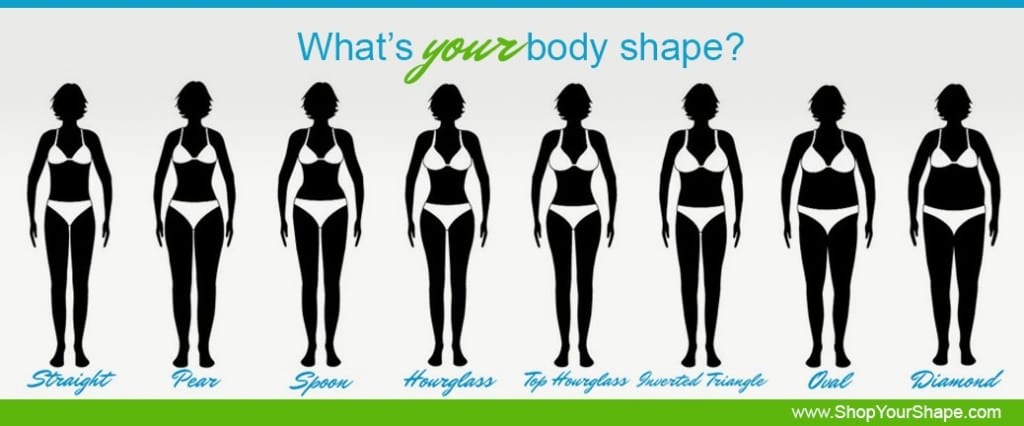Does this shirt make me look fat? Do these pants make my hips look big? These are questions we all face every day, but what we wear becomes an even larger issue when dressing for success in the show pen. We want to appear neat and clean, but there are more areas to consider when designing that perfect attention-getting outfit. No one’s body shape is exactly the same, and if we accentuate the wrong areas, this can be disastrous.
To help you create that ultimate first impression, four designing professionals–Paula Diuri of Paula’s Place, Lindsay Klempel of Silver Lining Custom Western Show Apparel, Wendy Brown of Show Me Again, and Babe Woods of Woods’ Western, offer their advice on dressing for success in the show pen.
Our bodies have unique shapes, but most people can be classified into one of eight categories as shown in the graphic (above). Knowing your body shape is crucial when it comes to designing an outfit, or finding a pre-owned outfit, that will help boost your confidence in the show pen. According to Klempel, “Most riders want to create an hour glass shape.” However, we weren’t all born with that perfect body shape, so the placement of color and design can help you achieve that ideal look.
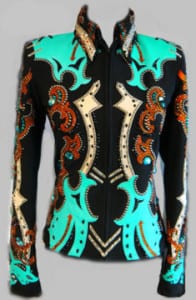 Beginning with the straight and pear body shape, Woods recommends a design that angles in at the waist. Also, a heavier design on the shoulders will make the waist appear smaller. Making the shoulders appear wider will help balance the wider lower section of the body. Extra designs or a wide belt/band around the hemline is not recommended for these body types. (Silver Lining jacket, right)
Beginning with the straight and pear body shape, Woods recommends a design that angles in at the waist. Also, a heavier design on the shoulders will make the waist appear smaller. Making the shoulders appear wider will help balance the wider lower section of the body. Extra designs or a wide belt/band around the hemline is not recommended for these body types. (Silver Lining jacket, right)
For riders wanting to slim their waistline, Klempel suggests keeping the design vertical, bringing it in at the waist and out at the bust and hip. However, Woods cautions that an exhibitor should only use straight lines if, “your posture is great and you can maintain that posture while riding because every little tip or sway will be accentuated.”
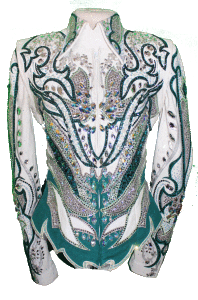 For those with a spoon, hourglass, or top hourglass body shape, Woods feels these are the body shapes that most people can dress very well: “When sitting in a saddle, that small waist with a proper fitting show top makes a very neat and trim picture.” (Paula’s Place jacket from Show Me Again, left)
For those with a spoon, hourglass, or top hourglass body shape, Woods feels these are the body shapes that most people can dress very well: “When sitting in a saddle, that small waist with a proper fitting show top makes a very neat and trim picture.” (Paula’s Place jacket from Show Me Again, left)
Brown suggests concentrating on the smaller waist and not drawing attention to the bust: “An open neck is a possibility but avoid going extreme in order to keep it classy.” Additionally, Brown feels that shoulder pads are a good idea if you have sloping shoulders: “This helps create the right shape and a flattering look in combination with an open collar.” In dressing for the top hourglass shape, Diuri says you need to be “careful with lines going over the bust area or too much design there.”
Looking at the inverted triangle shape, Diuri encourages the use of smaller shoulder pads so as not to emphasize the shoulder. Also, less design on the shoulder area is preferable. Brown agrees with Diuri and says that if you are uncomfortable wearing shoulder pads, they can even be removed, especially if you have a shorter neck. Woods adds that keeping a design set in a bit from the shoulders can further help to draw attention away from that wider shoulder area.
 In contrast with the inverted triangle shape, the oval and diamond body shapes call for an emphasis on the shoulder area. Woods recommends “angling designs toward the outside to draw the eye out.” Additionally, Klempel reinforces this idea by suggesting “the sides of the garment match the rider’s chaps or pants, as well as keep any design on the sides minimal.” An abstract, all-over design is appealing for this body type with lighter colors at the top. Belts or diagonal color splits are not recommended. (Woods’ Western right)
In contrast with the inverted triangle shape, the oval and diamond body shapes call for an emphasis on the shoulder area. Woods recommends “angling designs toward the outside to draw the eye out.” Additionally, Klempel reinforces this idea by suggesting “the sides of the garment match the rider’s chaps or pants, as well as keep any design on the sides minimal.” An abstract, all-over design is appealing for this body type with lighter colors at the top. Belts or diagonal color splits are not recommended. (Woods’ Western right)
According to Diuri, “it’s all about tying it together,” and broken lines in the middle will work against this goal. Both Diuri and Brown suggest wearing a vest or jacket in order to minimize the waist. Brown says, “It’s also acceptable to wear a horsemanship shirt with a coordinated vest over the top [that] goes outside the chaps to create a smooth long line.” Just be careful not to create a line in the middle. Woods suggests wearing a horsemanship top designed more like a rail top to be worn on the outside. This creates “a clean and much smoother look around the waistline when worn out” as long as the top and chaps match in color.
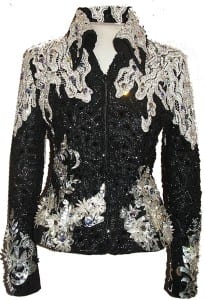 Besides just body shape, there are other issues to take into consideration when designing or finding your next show outfit. Height can play a major role in the designs you choose or create, especially since exhibitors desire the appearance of long legs. For showmanship, Brown encourages “exhibitors with shorter legs to raise the hemline of their showmanship jacket to give their legs a longer appearance. If a long jacket falls below the hip bones, it actually can make the leg appear shorter. If you are long-legged, you can wear the longer jackets.” (Show Me Again–left)
Besides just body shape, there are other issues to take into consideration when designing or finding your next show outfit. Height can play a major role in the designs you choose or create, especially since exhibitors desire the appearance of long legs. For showmanship, Brown encourages “exhibitors with shorter legs to raise the hemline of their showmanship jacket to give their legs a longer appearance. If a long jacket falls below the hip bones, it actually can make the leg appear shorter. If you are long-legged, you can wear the longer jackets.” (Show Me Again–left)
This works the opposite for the pleasure classes in which Klempel suggests that riders who want to appear taller should cut “a pleasure jacket slightly longer. [Also,] a design that runs vertically from the top of the piece to the bottom [will] create the illusion of height. This can be difficult with a horsemanship blouse where the design traditionally cuts off half up the garment. We like to continue the colors or design down further and not use a classic yolk towards the top, as that can cut somebody in half and make them appear shorter. “
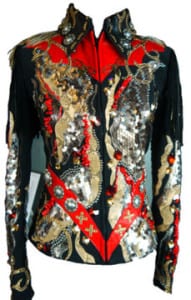 Exhibitors also contend with different torso sizes, which must be balanced with leg length. Diuri suggests that competitors with a long torso “carry the design deep down on the chest and back to fill in part of the length. Too much empty space will elongate the body.” Brown continues this idea in suggesting patterns that are busier. However, before dressing in bright, busy designs, you will need to consider some other factors. Brown cautions that if you “have a lot of waist and hip movement or if you have a really bouncy horse, you’ll want to minimize how busy your jacket is.” Clothes should be an addition to your performance, not a distraction. (Silver Lining Jacket, right)
Exhibitors also contend with different torso sizes, which must be balanced with leg length. Diuri suggests that competitors with a long torso “carry the design deep down on the chest and back to fill in part of the length. Too much empty space will elongate the body.” Brown continues this idea in suggesting patterns that are busier. However, before dressing in bright, busy designs, you will need to consider some other factors. Brown cautions that if you “have a lot of waist and hip movement or if you have a really bouncy horse, you’ll want to minimize how busy your jacket is.” Clothes should be an addition to your performance, not a distraction. (Silver Lining Jacket, right)
On the other extreme, exhibitors with short torsos are discouraged from wearing busy designs. A vest or jacket works well but avoid creating a broken line in the middle. This will accentuate the short torso. According to Diuri, the goal for an exhibitor with a short torso is “one solid flow.” Brown reinforces this idea in suggesting, “The base of your jacket needs to be solid and match your chaps to give that illusion of height.”
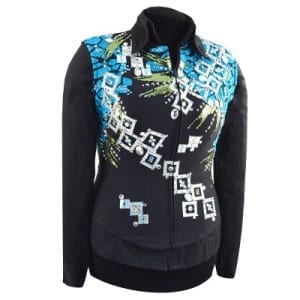 In designing that perfect outfit, the exhibitor is not the only consideration; the size of the horse in perspective to the exhibitor is also important. According to Woods, “a shorter person on a taller horse will want to keep the eye going up and down for added height.” Once again, maintaining a consistent color base will help accomplish the taller look for the competitor. Woods adds, “It is just the opposite if the rider is on the tall side for the size of her horse. You will want to draw the eye across the body to shorten it up. This can be done with a contrasting top and chap color.” (Woods’ Western vest, left)
In designing that perfect outfit, the exhibitor is not the only consideration; the size of the horse in perspective to the exhibitor is also important. According to Woods, “a shorter person on a taller horse will want to keep the eye going up and down for added height.” Once again, maintaining a consistent color base will help accomplish the taller look for the competitor. Woods adds, “It is just the opposite if the rider is on the tall side for the size of her horse. You will want to draw the eye across the body to shorten it up. This can be done with a contrasting top and chap color.” (Woods’ Western vest, left)
Dressing to match your body shape will help you achieve that much-needed confidence in the show pen. The key is to emphasize your body’s strong areas so those not-so-desirable areas will go unnoticed. At the same time, don’t be afraid to express your personality in the designs: choose your favorite colors, incorporate designs that represent who you are outside of the ring, and create your own personal style.
Woods encourages exhibitors to “get outside of your comfort zone on design and detail. Remember standing in front of the mirror looking at your reflection is not what the rest of us see. Two feet away from the mirror is also not what is seen in the show pen at forty feet away.” Overall, the key is that you feel confident and proud as you enter the show pen. Be proud of your one-of-a-kind body!



